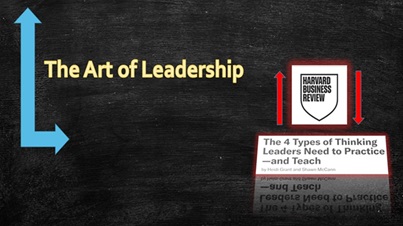
Mastering the Art of Leadership: Four Types of Thinking Government Executives Should Embrace

In an era defined by rapid technological change, geopolitical uncertainty, and heightened public expectations, government executives face a daunting mandate: to lead with clarity and ingenuity amid complexity. The recent Harvard Business Review article The 4 Types of Thinking Leaders Need to Practice—and Teach offers a compelling approach for leadership success, identifying four critical thinking skills—expert, critical, strategic, and systems thinking—as indispensable tools for adding value and essential for leaders to navigate complexity and deliver impact.
In government, adding value isn’t just about meeting expectations—it’s about exceeding them in ways that transform public service. As Heidi Grant and Shawn McCann argue in the HBR article, the true value emerges when leaders solve the right problems, often in unexpected ways, to achieve better outcomes. For government executives in 2025, these skills are not optional; they’re imperatives for tackling fiscal constraints, public distrust, and interconnected issues around effective governance.
This essay explores how these four thinking types can empower government leaders to solve the right problems, inspire their teams, and deliver outcomes that matter to citizens.
Expert Thinking: Leveraging Deep Knowledge in a Dynamic World
Expert thinking, rooted in deep domain knowledge, is the backbone of government operations. Built through years of experience and training, it enables executives to act swiftly and accurately, relying on ingrained patterns and heuristics. A budget director, for instance, uses expert thinking to spot inefficiencies in a spending plan, while a public safety official leverages it to deploy resources during a crisis. For government executives, this means mastering the intricacies of policy, regulation, and public administration—areas where precision and competence build credibility. As the article notes, experts distinguish fact from fiction—crucial when vetting AI-generated reports or policy proposals—where novices flounder.
Yet, in 2025, expertise alone is insufficient. The pace of change—driven by innovations like generative AI and shifting global alliances—demands that government leaders adapt their knowledge to new contexts.
The risk of over-reliance on expertise is complacency; what worked yesterday may fail tomorrow. Government executives must therefore pair their deep knowledge with humility, recognizing when to seek fresh perspectives. For example, during a cybersecurity crisis, an executive steeped in traditional IT protocols might need to consult younger tech-savvy staff to counter novel threats. Expert thinking, then, is not static—it’s a springboard for agility, enabling leaders to act decisively while remaining open to evolution.
Consider a public housing agency struggling with tenant complaints about slow elevators (mirroring the article’s scenario). An expert thinker might call a technician to fix or replace the lift—costly but effective in the short term. While this solves the immediate issue, it may miss broader needs, especially if resources are tight. For government leaders, expert thinking shines when quick, rule-based responses are needed—think disaster relief logistics or regulatory enforcement. To add value, however, they must pair it with openness to new domains, ensuring their expertise evolves with the times.
Critical Thinking: Re-frame Problems and Questioning Assumptions
If expert thinking provides the “what,” critical thinking supplies the “why.” It’s the ability to pause, evaluate evidence, and challenge assumptions—a skill vital for government executives navigating a landscape of competing narratives and public scrutiny.
Consider a government executive tasked with reforming a social welfare program. Expert thinking might suggest incremental tweaks based on past data, but critical thinking prompts deeper questions: Is the data current? Are we addressing the root causes of poverty, or just symptoms? By seeking diverse viewpoints, the executive can re-frame the problem, perhaps shifting focus from short-term aid to long-term economic realignment. This reflective approach can not only improves outcomes but may also rebuild public trust by demonstrating transparency and rigor.
Revisit the housing agency’s elevator woes. Tenants complain it’s slow, but a critical thinker asks: Why is it slow? Is it peak-hour congestion? If so, staggered move-in times could help. Or is the wait itself the issue? Adding lobby distractions—like signage or Wi-Fi—might ease frustration without costly repairs. As the article suggests, AI can aid here, prompting questions like: “What assumptions do I hold?” or “What’s the tenant perspective?” But as it cautions, critical thinking falters without expertise to guide it—novices lack the context to ask the right questions.
In 2025, with public trust waning, critical thinking helps executives justify decisions with rigor, not reflex. It’s best used when traditional fixes fail (e.g., recurring budget overruns) or experts clash (e.g., on trade policy). Teaching it requires encouraging teams to challenge norms safely—a culture shift for risk-averse bureaucracies.
Strategic Thinking: Seeing the Horizon Amid Daily Demands
Strategic thinking lifts government executives beyond daily crises to envision long-term possibilities.
It’s about asking, “What if?”—a mindset the article ties to imagination, not just analysis. It’s about anticipating trends, identifying opportunities, and aligning resources toward a vision—a tall order when budgets are tight and emergencies abound.
In a sector often mired in the status quo, this skill is a game-changer. Facing shrinking tax bases and aging infrastructure, a strategically minded leader doesn’t just patch potholes; they imagine a transit system that is safe, efficient, and on time.
Back to the elevator scenario: a strategic thinker might see tenant complaints as a chance to re-imagine the building’s purpose. Could it house tech startups needing modern amenities, justifying higher rents to fund upgrades? The article suggests AI prompts like “What are trends in vertical conveyance?”—for government, this could be “How will remote work affect office space needs?” In 2025, such foresight could turn a liability into an asset.
Strategic thinking fits big decisions—like workforce retraining or digital transformation—where the future hangs in the balance. Teaching it means giving teams permission to dream, perhaps through scenario planning workshops, despite the inertia of red tape. The risk? Bold moves can disrupt steady operations, but the reward is a government that shapes, not just reacts to, change -- turning reactive agencies into proactive change agents.
Systems Thinking: Connecting the Dots in a Fragmented Government
Systems thinking views government as an ecosystem—agencies, citizens, and external forces interwoven. The article calls it a way to “see the interconnectedness of things,” vital for tackling complex, emergent challenges. It requires visualizing interdependencies, often with tools like whiteboards—or AI prompts like “What patterns emerge in this system?”
Imagine a city grappling with homelessness. An expert thinker might fund more shelters, a critical thinker might question eligibility rules, and a strategic thinker might plan for affordable housing. But a systems thinker goes further, linking housing to job training, mental health services, and transportation access—coordinating across departments to create a cohesive strategy. This approach demands collaboration, a willingness to share credit, and an eye for unintended consequences (e.g., how a new policy might strain another sector).
For the elevator problem, a systems thinker maps the building’s ecosystem: tenant types, floor usage, stair habits, even external factors like nearby transit options or zoning shifts. Are tenants avoiding stairs due to safety? Does a new parking garage nearby increase demand? This holistic view might reveal that a freight elevator or better signage solves more than a faster lift.
For government executives, teaching systems thinking means modeling. It excels when complexity reigns—like coordinating disaster recovery across agencies. Teaching it involves cross-departmental collaboration, breaking silos to mirror the interconnected reality.
The article’s insight rings true: no single part owns the solution; value emerges from the collective.
Applying the Four Thinking Types: A Roadmap for Government Executives
The true power of these thinking types lies in their integration.
Expert thinking grounds decisions in knowledge, critical thinking ensures they’re sound, strategic thinking aligns them with the future, and systems thinking makes them holistic.
For government executives, this blend is a roadmap to adding value—solving the right problems in unexpected ways to achieve better outcomes.The article’s genius lies in its call to cycle through these thinking types, not pick one. An expert assesses the elevator’s mechanics, a critical thinker re-frames the complaint, a systems thinker maps the ecosystem, and a strategic thinker imagines a future-ready building.
For government executives, this cycle adds value by ensuring decisions are informed, questioned, contextualized, and visionary. Facing a cybersecurity breach, an expert patches the system, a critical thinker probes vulnerabilities, a systems thinker links IT to public trust, and a strategic thinker plans for a digital-first government.
Teaching this cycle demands teamwork—the article insists “every type of thinking is best done in teams.” Government leaders must foster diverse groups—veterans and newcomers, analysts and frontline staff—to ask better questions together. In 2025, with AI as a partner, executives can amplify this process, using prompts to spark insights while grounding outputs in human
Conclusion
As Grant and McCann argue, expert, critical, strategic, and systems thinking are “essential tools of modern leadership,” enabling leaders to add value by solving the right problems creatively.
In a world where problems defy simple solutions, these skills enable leaders to cut through noise, connect dots, and chart paths forward.
By embracing them personally and instilling them in their teams, government leaders can meet today’s challenges with the wisdom, creativity, and vision. They can deliver outcomes that exceed expectations—restoring faith in governance one thoughtful decision at a time. The future of governance depends on it.



